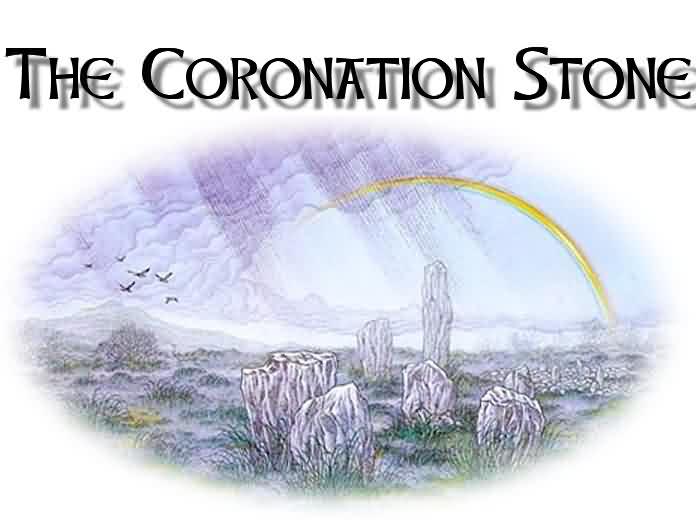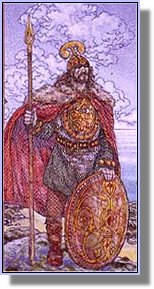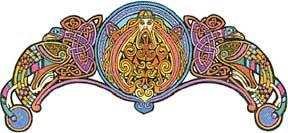|
 The Coronation Stone, or "Coisleach Aonghuis"
of the Clan Magennis stands at the entrance to a grassy trackway known as the "Bridle Loanen" on a ridge
overlooking the town of Warrenpoint, in
County Down. Nowadays it has rather less auspicious surroundings than in the
past, situated as it is within
a modern housing estate, but
nonetheless, to look on this ancient object is to be reminded of a
potent and mystical time in the history of the clan.
The stone is reputed to have been brought to Ireland from
the East by the distant ancestors of the Magennises, and is said to have had
all the magic that the famous "Lia Fáil",
or Stone of Destiny, at Tara
possessed. The Coronation Stone, or "Coisleach Aonghuis"
of the Clan Magennis stands at the entrance to a grassy trackway known as the "Bridle Loanen" on a ridge
overlooking the town of Warrenpoint, in
County Down. Nowadays it has rather less auspicious surroundings than in the
past, situated as it is within
a modern housing estate, but
nonetheless, to look on this ancient object is to be reminded of a
potent and mystical time in the history of the clan.
The stone is reputed to have been brought to Ireland from
the East by the distant ancestors of the Magennises, and is said to have had
all the magic that the famous "Lia Fáil",
or Stone of Destiny, at Tara
possessed.

 When a true Magennis was crowned on it, it is said to have emitted
a low, pleasant, humming
sound, but if a usurper dared put his foot in its sacred footmark, he was
dashed
to death on the ground by the power within the Stone. There is an old
prophecy connected with the Stone which holds that "wherever the Coisleach
Aonghuis stood,
a chief of the clan should there always reign supreme."
However, with the coming of Christianity to Ireland the Coronation Stone appears to have lost its ancient powers, as did all of the other
artefacts of the old religion, including the "Lia Fáil",
or Stone of Destiny, brought to the Hill of Tara thousands of years before by the
Tuatha Dé Danaan, the magical and semi-divine colonists
of
Ireland who preceded the Milesians, whose descendants still represent a large percentage of the
modern-day population. When a true Magennis was crowned on it, it is said to have emitted
a low, pleasant, humming
sound, but if a usurper dared put his foot in its sacred footmark, he was
dashed
to death on the ground by the power within the Stone. There is an old
prophecy connected with the Stone which holds that "wherever the Coisleach
Aonghuis stood,
a chief of the clan should there always reign supreme."
However, with the coming of Christianity to Ireland the Coronation Stone appears to have lost its ancient powers, as did all of the other
artefacts of the old religion, including the "Lia Fáil",
or Stone of Destiny, brought to the Hill of Tara thousands of years before by the
Tuatha Dé Danaan, the magical and semi-divine colonists
of
Ireland who preceded the Milesians, whose descendants still represent a large percentage of the
modern-day population.
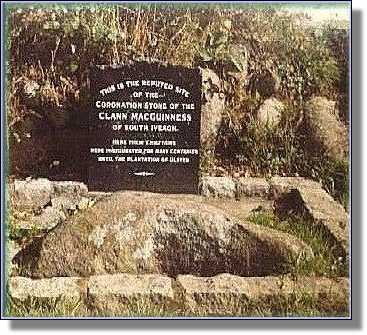
The ancient "Coisleach Aonghuis", of the Magennises.
"This is the reputed site of the Coronation Stone of the Clann Magennis of South Iveagh.
Here their chieftains were inaugurated for many centuries until the plantation of Ulster."

 Close by the Coronation Stone there formerly stood an ancient stone chair
called the "Brehon's Chair of Justice". It was formed of great stone slabs, on
which were
carved
figures representing some famous judgements given by the
Brehons or judges of former times. Unfortunately the slabs were broken up and
removed for
building
purposes as recently as the end of the 19th century.
This chair was said to be the seat of the chief Brehon who held there, on
Dromore Hill, an annual court of law. This part of Iveagh was divided into
districts called
"carrows"
or quarters, and each one sent a representative to
the convention to confer on the local laws and government of the clan, making
such alterations to the laws
as it was felt were needed. This "Rath of Justice"
on which they met was built up with earth from each quarter of the Magennis
territory, so that every law-maker stood
on his own ground, and each new measure
was read aloud to the whole assembled clan before it was passed as law. Close by the Coronation Stone there formerly stood an ancient stone chair
called the "Brehon's Chair of Justice". It was formed of great stone slabs, on
which were
carved
figures representing some famous judgements given by the
Brehons or judges of former times. Unfortunately the slabs were broken up and
removed for
building
purposes as recently as the end of the 19th century.
This chair was said to be the seat of the chief Brehon who held there, on
Dromore Hill, an annual court of law. This part of Iveagh was divided into
districts called
"carrows"
or quarters, and each one sent a representative to
the convention to confer on the local laws and government of the clan, making
such alterations to the laws
as it was felt were needed. This "Rath of Justice"
on which they met was built up with earth from each quarter of the Magennis
territory, so that every law-maker stood
on his own ground, and each new measure
was read aloud to the whole assembled clan before it was passed as law.
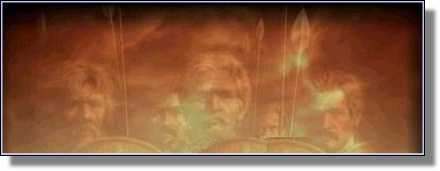
Out from the dust of centuries we see their long spears gleam,
And flash with glorious radiance, the radiance of a dream.
One moment that bright pageant lasts, it fades and dies away,
As fades e'er twilight's shadowy hour, the sun's departing ray.
For tanist, brehon, bard and kern, and abbots calm, severe,
Lie shrouded in the night that closed around his brief career.
All lonely now the chieftain's hill, swept by the winds -- "ochone",
Where all that's left of that proud past is the Coronation Stone.

 As a proud member of the clan to whom this ancient monolith was of such great
importance, I am
grateful on behalf of myself, those many Magennises
who preceded me, and those
yet to follow, to Councillor MacCartan, of Newry and Mourne District Council,
whom I believe was responsible for the preservation
and protection of the
Magennis Coronation Stone in recent years.
If you look at this
map of Ireland in 1300 A.D.
, you'll see that the Magennises and the MacCartans
were close neighbours, so
perhaps it is fitting, as a descendant of the clan which lived
side-by-side with my own through the many turbulent centuries of our country's
history,
that it was he who was involved in the survival and conservation of
our ancient "Coisleach Aonghuis"
As a proud member of the clan to whom this ancient monolith was of such great
importance, I am
grateful on behalf of myself, those many Magennises
who preceded me, and those
yet to follow, to Councillor MacCartan, of Newry and Mourne District Council,
whom I believe was responsible for the preservation
and protection of the
Magennis Coronation Stone in recent years.
If you look at this
map of Ireland in 1300 A.D.
, you'll see that the Magennises and the MacCartans
were close neighbours, so
perhaps it is fitting, as a descendant of the clan which lived
side-by-side with my own through the many turbulent centuries of our country's
history,
that it was he who was involved in the survival and conservation of
our ancient "Coisleach Aonghuis"
"Go raibh maith agat, a chara, agus beannacht Dé leat".

|
